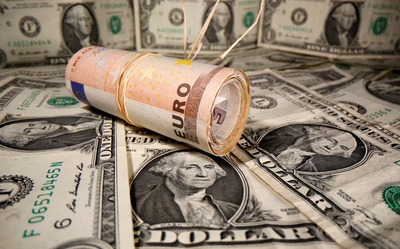Analysis-Shrinking US risk premium to divert more cash into Europe

(Reuters) - The premium investors enjoy from holding U.S. government debt over that of
The spread between U.S. and German 10-year bond yields reflects the difference in how much it costs each government to borrow over the long term.
It has fallen by 62 basis points (bps) since the start of the year to 158 bps, and is set for its biggest quarterly fall since the global financial crisis in 2008, excluding moves during the pandemic.
The gap reflects the divergence in interest rates and economic outlooks and is crucial for both investment flows and the euro/dollar exchange rate, which in turn affects trade balances, inflation levels, and corporate profits.
Since taking office on
U.S. economic data is starting to falter and investors are worried about a slowdown in growth, prompting a fall in Treasury yields.
"Fiscal policy outlook is now the main reason behind the current divergence between the euro area and the U.S.," said
Some analysts and investors believe the U.S./German spread, which is narrowing as German yields rise, could fall below 100 bps - a level not seen with any regularity since 2013.
"A recession should be a scenario when the Treasury yields collapse, and the spread goes to levels seen between 2000 and 2009 when it averaged 30 bps," said Padhraic Garvey, regional head of research Americas at ING, who sees the spread at below 100 bps, possibly at 75 bps.
Garvey said a recession is not ING's base-case for the U.S. economy. He sees Bund yields at 3.00-3.50% and said U.S. 10-year yields are close to neutrality at 4.3%.
U.S. Treasury Secretary
"Consumers feel threatened by possible layoffs not just in the government but also in the private sector," said
"Companies suffer from the uncertainty about U.S. tariffs. This backdrop is consistent with lower U.S. yields," Wizman added, arguing that "it is not inconceivable" to see a spread below 100 bps.
BID FOR BUNDS?
Barclays thinks Bund yields could test 3%, up from 2.8% now, if tariff risks do not materialise or are less intense than feared. U.S. 10-year yields are around 4.37%.
Higher yields tend to attract more capital from investors seeking better returns for their cash. The shift in the U.S./Bunds spread has supported the euro, which has gained 4% in the three months to March, its best quarterly performance since the fourth quarter of 2023. European stocks are set for their best first-quarter relative to U.S. stocks in a decade.
"Interest in
"Since the euro crisis, I have not seen so much interest in
Vasileios Gkionakis, senior economist at Aviva, meanwhile, says the link between nominal GDP growth and long-term yields could lead Bunds to 3.5%, with a potential overshoot to 4%.
However, higher government investment will stimulate growth and productivity given the boost in the public capital stock. That could strengthen the safe-haven appeal of German Bunds, which might in turn help limit a larger increase in yields and even push them lower.
(Reporting by
(c) Reuters 2025. All rights reserved. Republication or redistribution of Reuters content, including by caching, framing or similar means, is expressly prohibited without the prior written consent of Reuters. Reuters and the Reuters sphere logo are registered trademarks and trademarks of the Reuters group of companies around the world.
Related News

-
Trump stokes trade war as world reels from tariff shock
Reuters - 7:36 AM ET 4/3/2025
-
Markets reel as US tariffs stoke fear of 'spiral of doom' for growth
Reuters - 6:27 AM ET 4/3/2025
-
Reuters - 6:56 AM ET 4/3/2025
-
US announced job cuts surge in March on Doge hit, recruitment firm Challenger says
Reuters - 7:37 AM ET 4/3/2025
-
Analysis-Investors hunt for tariff-proof trades as new trade reality hits
Reuters - 6:06 AM ET 4/3/2025
-
China urges US to immediately lift tariffs, vows retaliation
Reuters - 7:40 AM ET 4/3/2025
-
Work on TikTok deal is 'in a good place,' US vice president says
Reuters - 47 minutes ago






